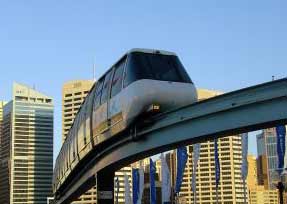What is Monorail?
It is an efficient, cost-effective, environment friendly mass transit system that helps people to commute with relative comfort and ease. As the name suggests, “a monorail is a single rail serving as a track for passenger or freight vehicles”. In most cases, the vehicle straddles a guideway, though there are monorails that are suspended from the guideway. Simply put, it is a wide train on a single narrow beam stretched between pylons so that the train runs at an elevation, above road and conventional rail traffic, though monorails can run on guideways at ground level and in subway tunnels.
What makes them desirable?
-
Construction of guideways for monorails causes the least amount of disruption of regular traffic when compared to subway systems or other rail systems.
-
Support pylons and guideways can be prefabricated and eased into prepared foundations on the route.
-
Pylons and beamways can be colored or embellished to blend in with the environment and greenery can be used to camouflage the support structures. .
-
Since noise pollution is minimal and the space occupied by the station is limited, monorails can be incorporated into the existing architecture of a historic district, the natural environment of a national park or a bustling shopping destination making it the ideal transportation for visitors and tourists.
-
Running on electricity or propelled by powerful magnets above the street level, with negligible wear on its rubber tires, monorails are known for their reliability, adherence to schedules and an enviable no-accident or derailment record.
The use of monorails for moving visitors around theme parks such as Disneyworld has created a ‘fun rail’ perception which does not do justice to the enormous potential of monorails as mass transit systems.
The biggest plus point in favor of monorails is their sizeable contribution to lowering the impact on the environment. Moving swiftly above road and rail traffic, monorails offer commuters a safe and economical alternative to driving, leading to fewer vehicles on the road and lower carbon emissions.










